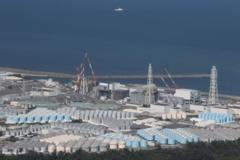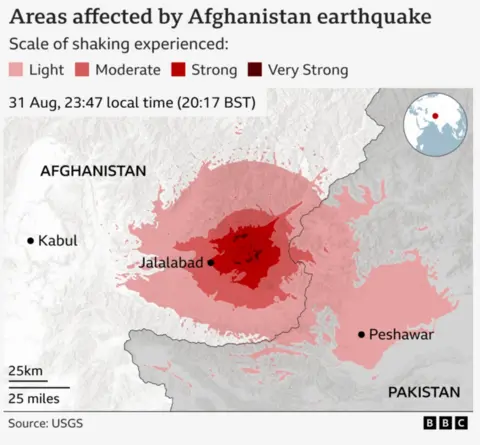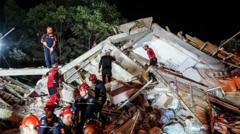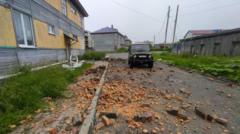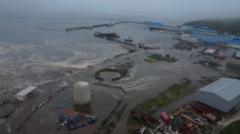On Wednesday, workers at the Fukushima nuclear plant were evacuated in response to tsunami warnings following an 8.7 magnitude earthquake off Russia's eastern coast. The evacuation revives memories of the catastrophic 2011 disaster, as cleanup efforts at the plant continue to pose significant challenges.
Fukushima, Japan - In a dramatic turn of events, all 4,000 workers at the Fukushima nuclear plant were evacuated early Wednesday as tsunami warnings swept across Japan, ignited by a powerful 8.7 magnitude earthquake off the far eastern coast of Russia. Despite the evacuation, the plant’s operator, Tokyo Electric Power Company (Tepco), reported that there were no detected abnormalities, ensuring that immediate safety protocols remained intact.
This recent alert brings forth haunting memories for many residents of Fukushima prefecture, reminiscent of the infamous triple disaster in March 2011. A catastrophic 9.0-magnitude earthquake triggered a massive tsunami that wreaked havoc, ultimately leading to one of the worst nuclear disasters in history. The tsunami inundated the plant, rendering emergency generators inoperable, resulting in a nuclear meltdown that released significant amounts of radioactive material into the atmosphere and the Pacific Ocean.
In the aftermath of the 2011 incident, a 30km exclusion zone was established around the plant, forcing over 150,000 residents to evacuate their homes, with many still unable to return due to persistent radiation concerns. The remains of deserted neighborhoods speak to the prolonged impact the disaster has had on local communities.
As the cleanup of the plant progresses, approximately 880 metric tons of hazardous materials—comprising melted nuclear fuel and structural debris—continue to pose considerable challenges to decommissioning efforts. Tepco has projected that full-scale removal of this debris will not commence until 2037 or later. Environmental experts have raised concerns that the ambitious timelines set for the plant’s decommissioning are unrealistic, given the significant hazards still present on-site.
Further complicating the cleanup process is the daily production of contaminated water, resulting from Tepco's efforts to cool down the reactors' fuel rods. This situation has resulted in over 1,000 storage tanks filled with contaminated water, an amount sufficient to fill more than 500 Olympic-sized swimming pools. As the nation grapples with the burden of storing this hazardous waste, Tepco has initiated controversial procedures to release treated wastewater into the ocean, prompting public protests despite assurances from the UN’s atomic regulators regarding the negligible environmental impact.
In a shift that may reflect a broader trend, Japan's government is reconsidering its stance on nuclear energy, aiming to boost reliance on nuclear power to satisfy increasing demands from sectors like artificial intelligence and semiconductor manufacturing. Kansai Electric Power has expressed intentions to explore new reactor construction, a project previously suspended after the Fukushima disaster. However, the recent tsunami alert has raised local concerns and opposition to such initiatives.
Japan, positioned on the Pacific Ring of Fire, experiences around 1,500 earthquakes annually, with many remaining apprehensive about the potential for a catastrophic "big one". Experts estimate a significant probability that a major earthquake could strike Japan's Nankai trough within the next 30 years, producing devastating tsunamis as high as 30 meters.
Wednesday’s tsunami warning serves as a stark reminder of the precarious balance between nuclear energy and the looming threat of natural disasters, marking an ongoing chapter in the complex narrative of Japan's post-Fukushima landscape.
Fukushima, Japan - In a dramatic turn of events, all 4,000 workers at the Fukushima nuclear plant were evacuated early Wednesday as tsunami warnings swept across Japan, ignited by a powerful 8.7 magnitude earthquake off the far eastern coast of Russia. Despite the evacuation, the plant’s operator, Tokyo Electric Power Company (Tepco), reported that there were no detected abnormalities, ensuring that immediate safety protocols remained intact.
This recent alert brings forth haunting memories for many residents of Fukushima prefecture, reminiscent of the infamous triple disaster in March 2011. A catastrophic 9.0-magnitude earthquake triggered a massive tsunami that wreaked havoc, ultimately leading to one of the worst nuclear disasters in history. The tsunami inundated the plant, rendering emergency generators inoperable, resulting in a nuclear meltdown that released significant amounts of radioactive material into the atmosphere and the Pacific Ocean.
In the aftermath of the 2011 incident, a 30km exclusion zone was established around the plant, forcing over 150,000 residents to evacuate their homes, with many still unable to return due to persistent radiation concerns. The remains of deserted neighborhoods speak to the prolonged impact the disaster has had on local communities.
As the cleanup of the plant progresses, approximately 880 metric tons of hazardous materials—comprising melted nuclear fuel and structural debris—continue to pose considerable challenges to decommissioning efforts. Tepco has projected that full-scale removal of this debris will not commence until 2037 or later. Environmental experts have raised concerns that the ambitious timelines set for the plant’s decommissioning are unrealistic, given the significant hazards still present on-site.
Further complicating the cleanup process is the daily production of contaminated water, resulting from Tepco's efforts to cool down the reactors' fuel rods. This situation has resulted in over 1,000 storage tanks filled with contaminated water, an amount sufficient to fill more than 500 Olympic-sized swimming pools. As the nation grapples with the burden of storing this hazardous waste, Tepco has initiated controversial procedures to release treated wastewater into the ocean, prompting public protests despite assurances from the UN’s atomic regulators regarding the negligible environmental impact.
In a shift that may reflect a broader trend, Japan's government is reconsidering its stance on nuclear energy, aiming to boost reliance on nuclear power to satisfy increasing demands from sectors like artificial intelligence and semiconductor manufacturing. Kansai Electric Power has expressed intentions to explore new reactor construction, a project previously suspended after the Fukushima disaster. However, the recent tsunami alert has raised local concerns and opposition to such initiatives.
Japan, positioned on the Pacific Ring of Fire, experiences around 1,500 earthquakes annually, with many remaining apprehensive about the potential for a catastrophic "big one". Experts estimate a significant probability that a major earthquake could strike Japan's Nankai trough within the next 30 years, producing devastating tsunamis as high as 30 meters.
Wednesday’s tsunami warning serves as a stark reminder of the precarious balance between nuclear energy and the looming threat of natural disasters, marking an ongoing chapter in the complex narrative of Japan's post-Fukushima landscape.

